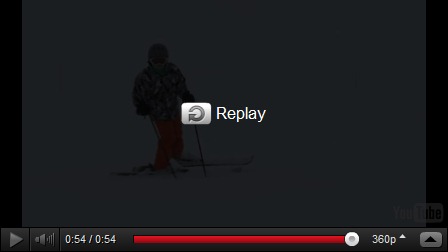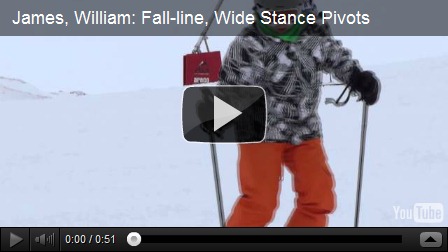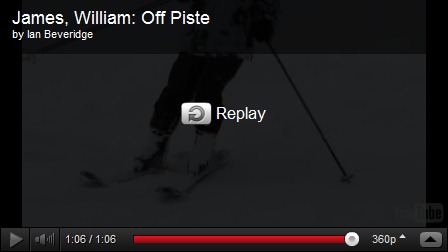James and William appeared to have very different problems in their skiing so I had to try to begin the technical session by finding a common denominator. They both struggled most in fall-line skiing – so it was clear that working on pivoting and fall line skiing would be a sensible place to begin. James would always be caught out leaning back and accelerating out of control with no use of his ski poles. William couldn’t stand on his outside ski with a strong commitment and so fell over frequently when his weight went on the “wrong” ski.
One Ski
Working on standing on one leg and pivoting on one leg is a direct way to address both issues of leaning back and commitment to the support leg. In a way both are issues of commitment to standing on one leg. The leaning on the back of the ski boot can only work when supporting yourself on two skis instead of one. James was able to ski on one ski but had very little edge awareness and couldn’t control his speed or turn radius. William predictably just fell over or put his other leg on the snow. This was more of a test than anything else at this stage. James couldn’t lean on the back of the ski boot when on one leg but he still had the problems of not completing the turns and speed control. William clearly found standing on one leg hard and that’s probably why he skis a lot with his feet close together – so he can stand on two feet. At this stage there were no clear signs of the underlying issues that might be generating the problems.
One Ski Pivot
We started working on the “outside ski” pivot without spending any time preparing for this with sideslipping. Standing on the uphill ski the idea was to sideslip with the foot rolled onto its inside (lower) edge and the ski held on its uphill edge. This was quickly achieved so we did the exercise for the adductor muscle awareness by lifting the ski off the snow and pulling the ski tip against my ski pole planted in the snow. William let his heel come out when he did this which showed that he was twisting the leg outwards instead of pulling inwards with his adductor muscles. This was corrected and the new awareness was then added to the pivot. Despite their best efforts both were affected by strong upper body (shoulders and hips) rotation. They were leading into the turns with the upper body to try to force the ski around. The hips nearly always started the turn by being forced to the outside of the turn. Working on the “inside ski pivot”, which is trickier, the rotation problems were even clearer and harder for them to avoid. They consciously tried to stop rotation both at the start and end of the turns. I explained how rotating kept the body mass to the outside of the turn and made everything difficult. The advantage of stopping rotation and facing downhill is that the body can be shaped during the second half of the turn to keep the centre of mass low and inside the turn, so as to complete the turn. At the start of the turn rotation interferes with dynamics and so the ski can’t work. The rotation stops the body from falling into the turn and as I explained the skier’s job is to fall – and the ski’s job is to lift the skier up.
Windscreen Wipers
The pivot could not improve without eliminating this chronic rotation so this became the main target. Along with the rotation there were significant postural issues emerging. William had worked on posture few days earlier and it appeared to have made a difference because he wasn’t bending his spine in all directions as he had been previously. James on the other hand was hollowing his back and along with his hips his bottom would frequently go to the outside of the turn. This has to be corrected to protect the lower back from injury. I asked James to tilt his pelvis up at the front without letting his shoulders fall backwards – so that the stomach tightened. When James did this he locked up his hip joints and when asked to bend at the hips he bent at the waist only. This was corrected. The pelvis needs to the pulled up but the hips must also be released. We removed the skis and stood on a steep pitch facing downhill and with the heels dug into the snow. Both poles were planted downhill for support and the legs were rotated in their hip sockets so that the feet swung like windscreen wipers in front – from side to side. Initially both James and William allowed the pelvis to rotate but we rapidly brought this under control so that only the legs moved. I explained that in this wide stance both skis could pivot independently and both feet could be kept at the same height across the mountain, below the body. The idea was to ski directly down the fall-line with each leg pivoting independently and absolutely no travel of the body across the hill and without the hips or body coming around at all – as they have to when the feet are together. As you can see in the video above they didn’t really manage that level of control but it did contribute to raising awareness of posture and rotation issues.
Compression Turns
It was becoming clear that rotation was still not being brought under control so more extreme things had to be attempted. Compression turns are very difficult for most people to learn so it was a long-shot. The compression turn simulates bump skiing but on flat terrain. It’s necessary to flex the legs all the way to 90° at both the hip and the knees while moving the body down into the turn, relying on strong pole support. The key is to feel the body pulling the skis down into the turn. My hope was that this low flexed position would fight against the tendency for the boys to thrust their hips up and outwards. James had a serious breakthrough with this and suddenly understood how to keep his hips to the inside of the turn. William was a bit slower to catch on but also got there in the end. The clear breakthrough made it obvious that the rotation issues were coming from up/down timing so after working on the compressions for a while I decided to move on to skating (down/up timing) and see how they would both react to that.
Skating Timing
Both William and James can skate well but they were slightly confused as to how this applied to skiing. Working with the “direct method” and knowing they had done this many years ago, I went straight into skating directly downhill and then adding dynamics to get the skis to turn during the skating. William had some trouble understanding that I didn’t want the skis to “rail” as in carving but I wanted a continuous pivot on the inside edge from the start of the turn. He eventually came clear on this issue. At this stage William showed stronger skating than James. James had very little range of movement during the skate but quickly changed that when it was pointed out. The most revealing thing happened when the skating was then taken directly into the pivot. William completely lost the skate and did the opposite, reverting back to his initial rotation problems. It was now clear that his rotation was coming from this timing problem. He also started to use a downsink/poleplant a the end of each turn and stood up rotating to start the next turn. It looks very much like he has picked up this timing through being taught it – though I have never taught it to him. It is the cause of all his main problems. James in contrast completely held it together. While William fell apart as it got steeper James managed to bring everything together to work for him. The difference is very clear in the video. James has correct down/up skating timing in the pivot and good control over rotation with good ski edge awareness. William has returned to his old unconscious habits that look like they have been drilled into place by a ski school. The scary thing is that some people only need to be taught that bad timing once and then it takes a lifetime to stop it from dominating everything. I explained to James that the push up from the skate at the end of the pivot can be used on the steep to push the body back up the hill to really slow down and have a strong braking effect. It can also be used to lift the body outwards – almost downhill to get in a good place – perpendicular to the hill to then fall into the next turn when in difficult snow. It’s vigorous work for the legs and James felt this. I explained that when skating in longer turns there was only a “pole touch” at the start of the new turn as the body fell into the turn and the pole was only moved by a flick of the wrist. This is in contrast to the strong downhill pole support in braking/fall-line skiing were the feet are always downhill. Either way the pole plant indicates the entry into a turn – not the end.
Off Piste
Once William’s predicament was clear I asked him to focus on only downsinking – as in the compression turns – into each turn. This was the only thing that could break his timing and rotation issues. In his final run off piste he managed this to some extent, but not enough to prevent one fall. James gets it right and has a strong basic pivoting platform with good timing, good control over rotation, independent leg action and is well centred over his skis (but just slightly back).
Conclusion
Both boys will have to be ultra careful about picking up bad technique from ski schools or even from their own defensive reactions. They must realise that although it’s fun to blast around they have to take some time out to think – correctly and intelligently – or their skiing will definitely degenerate. The main problem for both of them stemmed from incorrect timing. James’s reaction to this timing and consequent rotation had been to go two footed and lean against the back of the boots in deep snow. The rotation meant he couldn’t sink down into the turn and complete the turn so he would pick up more speed and then lean harder on the back of the boots – a vicious circle of events. William reacted to the same issue by tilting his head and shoulders into the turn and thus frequently ending up on his inside ski and losing the reflex to stand on his outside ski. This is why he keeps on falling over. These problems have to be dealt with in a disciplined manner or they can develop into life-long characteristics.






